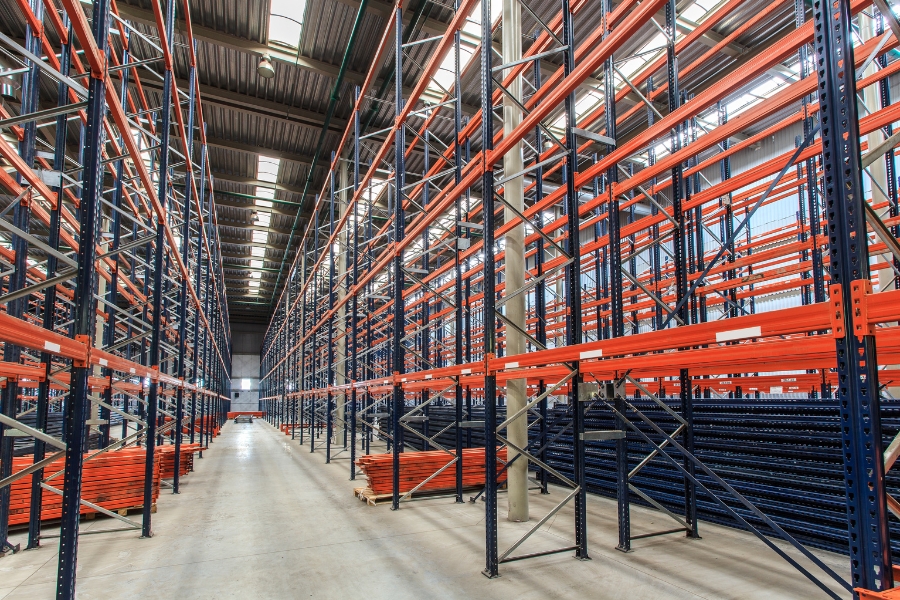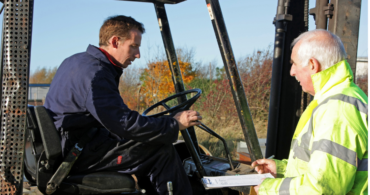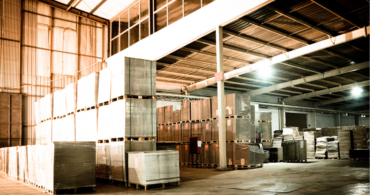Warehouses were once one-size-fits-all airplane hangar-sized buildings with crates haphazardly stacked throughout the structure (this is primarily conjecture based on the historical documentary “Raiders of the Lost Ark”). Today’s supply chain requires warehouses to be much more efficient and streamlined than those (possibly completely fictional) past iterations. To help achieve this wide variety of storage goals, warehouses utilize a variety of pallet racking types.
The heart of every well-organized warehouse is its pallet racking system. The correct racking can help optimize space and enhance productivity. However, choose the wrong racking for your needs and your business will likely see a noticeable productivity dip. Read on to discover answers to the age-old question, “What is pallet racking?” and discover if your warehouse uses the best racks for your business needs.
What is a pallet rack?
A pallet rack—also known as a pallet racking system, a forklift rack or forklift racking—is a series of upright frames and horizontal beams that create multiple storage levels where pallets are kept safe and organized. Pallet racks are primarily used in warehouses, distribution centers and other storage facilities.
The primary purpose of pallet racks is to optimize storage space, increase efficiency and ensure that it is as easy as possible to access stored goods. In short, pallet racks allow warehouse owners and operators to utilize their space efficiently.
Pallet racks come in various types, each designed for specific storage requirements and products.
Selecting the right pallet racking types
Selecting the correct type of racking pallet can significantly impact a storage facility’s productivity. To make the best choice for your business, consider the following factors:
Storage requirements
Pallet racking systems are designed to hold specific cargo. This is determined based on the product’s dimensions, weight and handling needs. Take careful inventory of the type and size of the merchandise to be stored, including its weight and how often you need to access it.
Available space
The existing floor space and the vertical height of your facility play a critical role in selecting the right racking for pallets.
Accessibility
Consider how often and how quickly you need to store and access items. Some pallet racking systems provide direct access to every pallet, while others offer more storage but can make it challenging to access some things quickly.
Inventory rotation
Determine your storage policy before acquiring any storage systems. The two most common are “first-in, first-out” and “last-in, first-out.”
- First-in, first-out (FIFO): The oldest inventory is sold first, and the newest inventory remains in stock. This method is especially suitable for businesses dealing with perishable or time-sensitive goods since it ensures that older inventory is used before it becomes obsolete or expires.
- Last-in, first-out (LIFO): The newest inventory is sold first, and the older inventory remains in stock. LIFO is primarily used as an inventory valuation method to determine the cost of goods sold and the value of remaining inventory. A criticism of LIFO is that it does not accurately represent the actual physical flow of stock. In practice, items are often sold in a different order than they were acquired or produced.
Existing equipment
Any business upgrading its current shelving, rearranging its floorplan or both needs to double-check that its existing forklifts and other material handling equipment are compatible with the upgrades.
Upfront costs
Carefully review how the purchasing and installation costs may affect your long-term budget. Some complex systems may have higher initial costs but could result in long-term efficiencies that help boost profits.
Safety considerations
Every area and region have special safety rules and standards. If the new racking system is not in compliance, it is going to cost both time and money to fix the issue.
Future needs
If future expansions are possible, some pallet racking systems can be easily reconfigured or expanded as your inventory and operational needs change.
Types of pallet racks
Many different types of pallet racks serve specific storage needs and help optimize warehouse storage space.
Selective pallet rack
A selective pallet rack is currently the most common type of pallet rack. They are exactly what you picture when you think of warehouse storage shelving. Selective racks make loading and unloading individual items easy because they allow forklifts direct access to any pallet.
These racks are suitable for storing a wide range of products with varying sizes, weights and SKUs, making them ideal for facilities with diverse inventory. Each level of the rack can be adjusted for height to accommodate items of different sizes.
A selective pallet rack is relatively straightforward to install and can be easily expanded or reconfigured to adapt to changing storage needs. However, selective racks provide less storage density than other racks and use a great deal of floor space because they require many aisles.
Double-deep pallet rack
A double-deep pallet rack is a variation of a selective pallet rack. True to their name, double-deep pallet racks allow two pallets to be stored in the same slot. Forklifts can access the pallets from either side of the racks. Double-deep pallet racks are customizable and can accommodate various pallet sizes, load capacities and aisle configurations.
A double-deep pallet rack provides higher storage density than standard selective pallet rack and optimizes floor space by reducing the number of aisles. They also increase storage without needing specialized equipment or forklifts. These racks are suited for bulk storage of units with the same SKU, where stock rotation is not the primary concern.
Drive-in rack
Drive-in racks earn their name because forklifts literally drive into the racks to load and unload cargo. These racks are comprised of sturdy, vertical frames with horizontal load beams. These structures have no shelves. Instead, pallets are stored one after the other directly on the load beams.
Because drive-in racks allow forklifts to enter the rack structure, they eliminate the need for aisles between every rack unit, which maximizes the available floor space. However, only the pallet at the front of each lane is directly accessible. As a result, businesses that utilize drive-in racks must employ last-in, first-out inventory management. This makes drive-in pallet racks suitable for smaller warehouses and ones that store inventory with no “use by” date, such as non-perishable and manufactured materials.
Drive-through pallet rack
Drive-through pallet racks (also known as drive-thru racks) have the same set-up as drive-in pallet racks, except that forklifts can drive in one side and exit from the other. This creates a flow-through system where pallets are loaded from one side of the rack and retrieved from the opposite side. Since forklifts can move in both directions within the rack system, proper traffic management is crucial to prevent collisions and ensure smooth operations.
Because inventory is accessible from both ends, drive-through pallet racks are a first-in, first-out warehouse storage solution. Warehouses storing perishable items and products that move quickly often use drive-through pallet racks.
Both drive-in and drive-through pallet racks often have “off-set” or “cant” (short for cantilevered) legs, where the lowest portion of the front columns recess inward to avoid getting clipped by forklifts.
Push-back rack
The “shelves” of a push-back rack system incline slightly toward the central aisle and are equipped with several rolling carts. A forklift sets a pallet on the rolling cart closest to the central aisle to load inventory. To place a second, the forklift operator lines up the pallet they’re loading with the one on the rack and pushes against it. This process repeats until the lane fills. When a pallet is removed, gravity pulls the one behind it to the front of the row. Push-back racks are most effective when storing large quantities of the same product.
Pallet flow rack
A pallet flow rack goes by many names, including gravity flow rack and dynamic flow rack. Pallet flow racks utilize inclined roller tracks or skate wheels within the rack structure. Pallets are loaded onto the higher end of the tracks, and due to the inclined nature of the system, they move smoothly and gradually toward the unloading end. Because pallets are loaded toward the back of the rack and retrieved from the front, pallet flow racks are used by businesses employing a first-in, first-out inventory management method.
Cantilever pallet rack
If you’ve ever been to the lumber department of a home improvement store, you’ve seen cantilever racks in action. This type of warehouse storage has no shelves, just a series of load-bearing arms to accommodate long products, such as lumber, pipes, molding, metal sheets, etc. The length and number of arms can be customized to meet specific storage needs.
Cantilever racks can be configured as single-sided, with arms on one side of the vertical columns, or double-sided, with arms on both sides. Double-sided configurations allow for higher storage capacity in essentially the same footprint as the single-sided racks. Some cantilever racks use weather-resistant materials for outdoor storage. Cantilever racks are used by businesses that manage automotive, home decor, machinery and component products.
Mobile pallet rack
Mobile pallet racks sit on bases that roll along rails lining the warehouse floor. These moving pallet racks slide laterally along these rails, manually or automatically, to allow access to inventory. These systems are customizable to fit various pallet sizes and weight capacities. The number of mobile bases and their arrangement can be tailored to suit the specific storage requirements of the facility. Most mobile racking units only accommodate a single pallet per storage slot.
Since mobile racking systems need fewer aisles, they dramatically improve a warehouse’s storage capacity. For example, to save on cooling costs, freezer warehouses and cold-storage facilities often use mobile racking systems to maximize the storage space of a small area. However, they are a more complex and costly investment compared to traditional pallet racking systems.
Pallet shuttle rack
A pallet shuttle rack (also wonderfully known as a pallet mole) is designed to maximize storage efficiency. Here’s how it works.
The heart of the pallet shuttle rack system is a shuttle vehicle that moves along the racking structure. The shuttle is a motorized platform that lifts and carries pallets to designated storage locations within the rack. The pallet shuttle moves on rails or tracks installed at each level of the racking system. These rails allow the shuttle to move smoothly and securely within the racking structure.
The shuttle is typically controlled remotely by warehouse personnel. They direct the shuttle to move pallets to specific storage locations and retrieve them when needed. Depending on the configuration and warehouse needs, pallet shuttle rack systems can be set up for first-in, first-out and last-in, first-out inventory management methods.
The future of pallet racks
While extremely cutting-edge pallet racking types exist, like shuttle racks and mobile racks, some current technologies will likely be implemented with pallet racking systems that could revolutionize warehouse storage and operations.
Automated guided vehicles (AGVS) and robotics
Automated guided vehicles and robotic systems will continue to play a significant role in pallet racking operations. Autonomous and remote-controlled vehicles can navigate warehouses, retrieve pallets and transport them to designated locations to streamline the material handling processes.
Internet of Things (IoT) and data analytics
When IoT sensors and data analytics are used to monitor pallet racking systems and warehouse performance in real time, the technology provides valuable insights into inventory levels, maintenance needs and operational efficiency, leading to better decision-making and optimized warehouse management.
Augmented reality (AR) and virtual reality (VR)
Once relegated to that feature you don’t use on your phone’s map app, catching Pokémon in the “real” world and gaming systems no one is buying, augmented reality and virtual reality are beginning to be used for complex pallet racking warehouse training operations. These technologies can put employees in the middle of previously potentially dangerous training exercises to improve safety and reduce the learning curve when new employees hit the warehouse floor IRL.
Energy-efficient designs
As more industries realize the need for energy-efficient processes and operations, eco-friendly pallet-racking solutions will gain popularity. Manufacturers are increasingly using sustainable materials and adopting designs that minimize environmental impact.
Artificial intelligence (AI) for inventory management
AI-powered algorithms are currently being used to forecast inventory demand and management. Because AI can analyze historical data, market trends and customer behavior, businesses will continue to use it to optimize inventory levels and improve supply chain efficiency.
At Texas Motive Solutions, we want to ensure that your forklift fleet is running at peak efficiency, so they are constantly loading and unloading all types of pallet racks. That’s why we offer our complimentary forklift fleet performance analysis. For all your forklift repair and forklift battery maintenance needs, give us a call at (888) 316-2459, or you can fill out this form to learn about our services and discover everything we can do for you.


